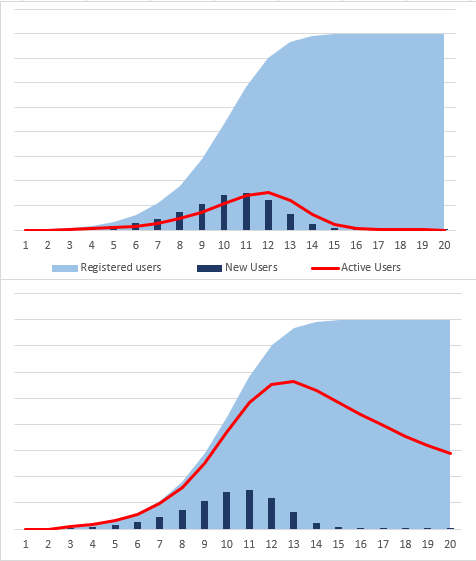- ARPDAUPosted 12 years ago
- What’s an impressive conversion rate? And other stats updatesPosted 12 years ago
- Your quick guide to metricsPosted 12 years ago
ARM yourself in a post-viral world
Building a sustainable online business is tough. There are so many aspects from getting customers to serving them to making money from them that it can be very easy to be overwhelmed by all of the ideas that you and your team have to implement. It is often a struggle to work out where your priorities lie.

For the past couple of years, I have been using a framework I call ARM yourself to think about how to improve the businesses I work with. It has been extremely useful for finding the gaps in a company’s business and for making quick, simple tweaks which have a major impact on the bottom line.
I’ve decided to share it with you.
ARM yourself for fun and profit
The three letter acronym ARM stands for:
- Acquisition: How do I get people through the door cost-effectively?
- Retention: How do I keep people coming back for more?
- Monetisation: How do I build money-making strategies into gameplay?
Over the next few weeks, I will write a separate post on each aspect, and how the tricks you can use to improve your business. This post, however, is to explain how the three aspects work together to make a profitable whole.
Get your business in total ARMony (sorry)
In the long run, it is essential that Acquisition, Retention and Monetisation are in harmony. Yet time and again I see companies for whom only one or two of the three aspects are included in the planning of new features or development. Usually, but not always, Retention is the aspect that is omitted.
(As always, there is an exception to the rule of harmony. Facebook and Twitter made big businesses and attracted great investors with no monetisation strategy. However, unless your business aims to be truly transformational, and very few games businesses are, I think it would be a mistake to ignore monetisation from your planning.)
Consider these (fictional) examples of companies that don’t have all three business in harmony:
- A company spending £10,000 a month on Google Adwords and obsessing about conversion rates from registration to purchase, but putting zero effort into persuading users to come back the following month and making another purchase (a.k.a the leaky bucket)
- A company that aims to build a massive business but has no idea how it will make money (a.k.a the Facebook wannabe)
- A company that spends no effort on marketing and obsesses about retention and monetisation rates (a.k.a the unknown startup).
All three of these examples have glaring holes in their business model. Once you apply the ARM yourself framework, the holes become obvious, and it is much easier to prioritise new features and development resources.
Which should I be?
Obviously, I think you should keep all three in balance. But if you have to pick, especially if you are a game company, I would choose to be the unknown startup. And here’s why:
- Acquisition is just a question of money. There are clever, cost-effective ways of getting CPA down, but if you can’t do that, you can always throw a shipload of money at the problem. That means that competitors with better funding will win on Acqusition, so this is not where I would choose to compete.
- There has, historically, been a route to fast success through focusing on viral Acquisition. Think Skype, Zynga, Playfish, Facebook itself. I think that that the viral boom is over. Not only has Facebook effectively shut down all viral channels on its own platform, but consumers are getting more wary about signing up for new services of any type. Virality is still great if you can achieve it, but it is so hard that it is not where I would invest my scarce resources.
- Retention, and to a lesser extent, monetisation are entirely within your control. We make games, right? And the key skill of designing a good game is about leaving players wanting more, whether that be “one more go” or “come back tomorrow”. That means we have a ready-made advantage in competing on Retention. It is our secret sauce, and we should use it.
- Monetisation is critical to all businesses. Having revenues means you are in control of your own destiny. As I have posted before, having only 1,000 users is not a disaster if you have good conversion, retention and ARPU rates. So I would prioritise finding a route to profitability.
To sum up
ARMing yourself is a great way to look for gaps in your business. Take two minutes to do it, right now. Think to yourself:
- Am I getting people to come to my website/game?
- Are they staying?
- Are they making me enough money each?
If you don’t know the answer off the top of your head, go and ask your CTO, your team, or, even more valuably, the data and metrics you collect from your users.
I will be posting more details on Acquisition, Retention and Monetisation over the next few weeks.
But if this framework hasn’t already given you a bunch of ideas for improving your business, I’ll be very surprised.













